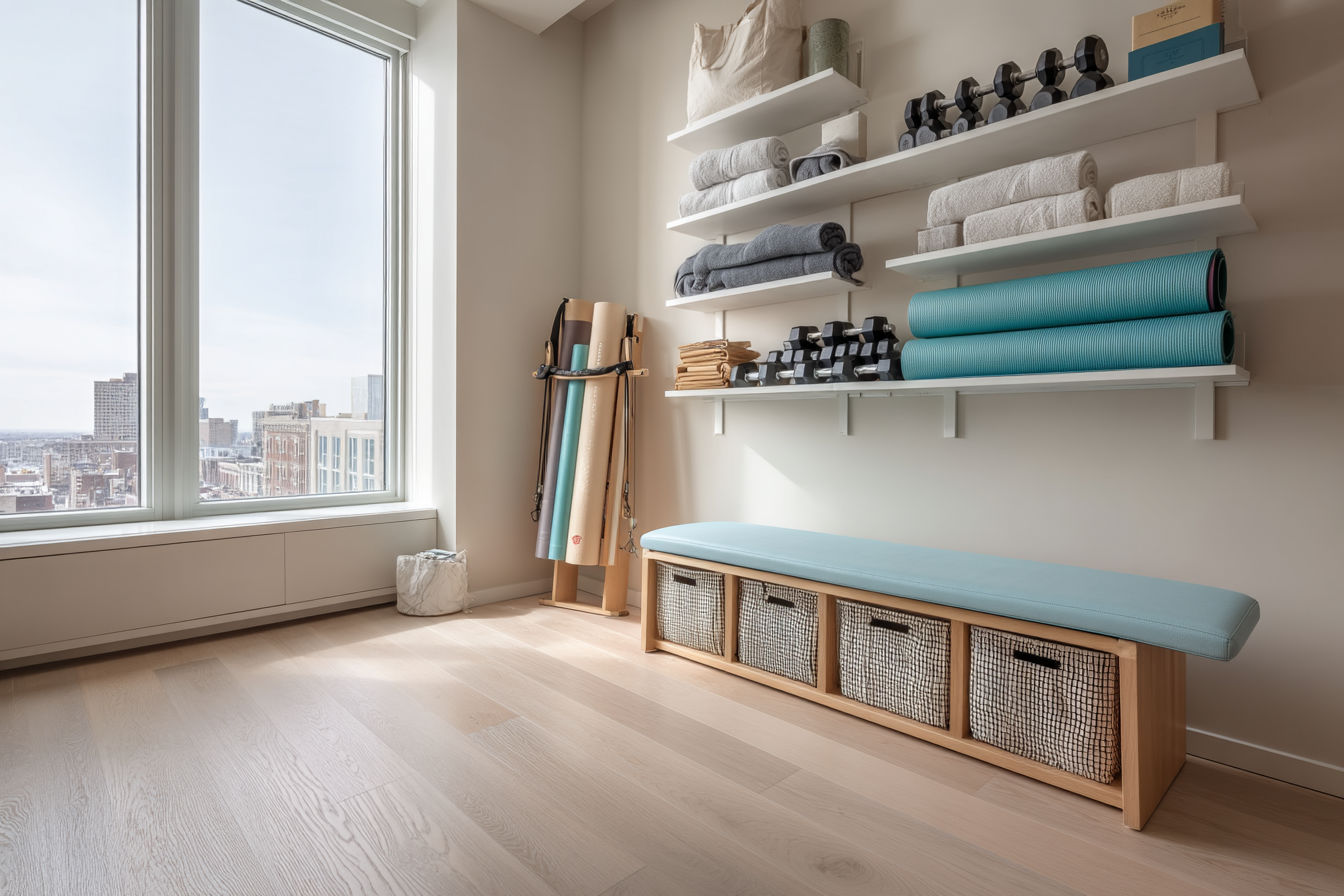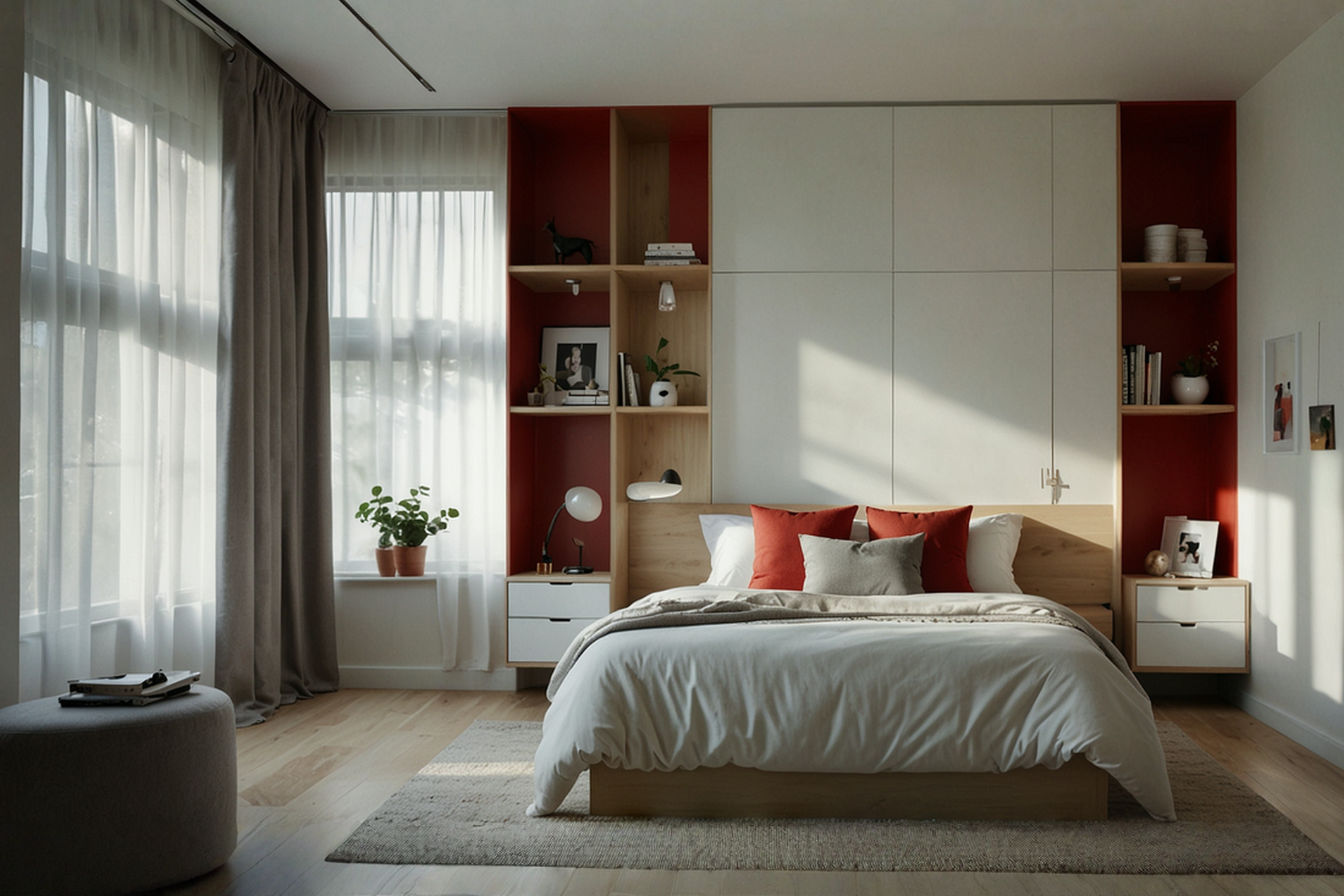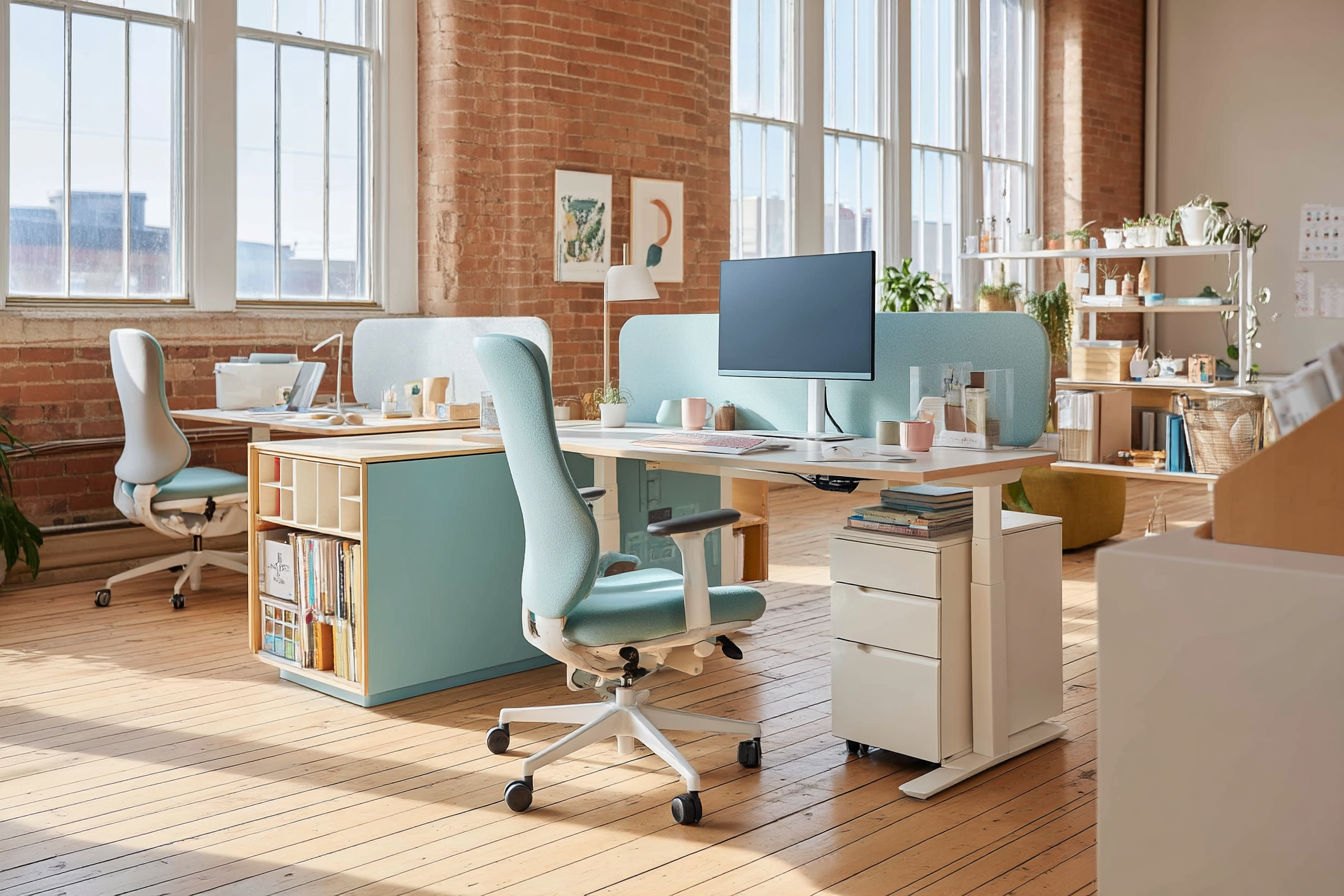This post may contain affiliate links. If you make a purchase through these links, we may earn a commission at no additional cost to you.
In today’s fast-paced professional environment, your workspace significantly impacts your productivity, health, and overall job satisfaction. The average knowledge worker spends over 1,700 hours yearly at their desk—a sobering statistic that highlights why thoughtful workplace design matters. Far too often, professionals find themselves choosing between furniture that supports their physical wellbeing and pieces that reflect their aesthetic sensibilities.
This false dichotomy between function and form finds its resolution in the innovative designs of USM Haller. Born from the brilliant collaboration of Swiss engineer Paul Schärer and architect Fritz Haller in 1963, USM Haller systems have revolutionized workplace design through their perfect marriage of ergonomic principles and timeless style. Their iconic modular furniture solutions stand as a testament to the idea that workspaces can simultaneously support human physiology and elevate environmental aesthetics.
Unlike conventional office furnishings that prioritize either comfort or appearance, USM Haller systems embrace a holistic approach to workplace design. Their modular components work together seamlessly to create environments that adapt to human needs while maintaining a distinctive visual identity recognized in design museums worldwide.
This comprehensive guide explores nine remarkable USM Haller systems that can transform your workday experience. From height-adjustable desks that promote movement to innovative acoustical solutions that enhance concentration, these carefully engineered components create workspaces that support your body, mind, and professional goals—all while making a powerful design statement.
The USM Haller Design Philosophy: Where Ergonomics Meets Aesthetics
The story of USM Haller begins in 1963 in Münsingen, Switzerland, when entrepreneur Paul Schärer commissioned architect Fritz Haller to design a flexible, modular building for the USM company’s headquarters. This collaboration extended beyond architecture into furniture design, resulting in a revolutionary modular system built around an ingenious ball joint connector. This patented connection became the cornerstone of an endlessly adaptable furniture system that has remained virtually unchanged for over six decades—a testament to its exceptional design integrity.
At the heart of USM Haller’s design philosophy lies an unwavering commitment to key principles that inform every piece. Modularity serves as the foundation, with all components working together in a unified system that can evolve with changing needs. This adaptability allows furniture configurations to transform as requirements shift, representing a sustainable alternative to disposable office furnishings. The system’s durability derives from high-quality materials and precision engineering, ensuring each piece maintains its functionality and appearance for decades.
The signature chrome-plated brass ball joints that connect powder-coated steel tubes create the distinctive aesthetic that has earned USM Haller a permanent place in the Museum of Modern Art’s collection since 2001. These precision-engineered components not only look sophisticated but also enable limitless customization possibilities. Available in fourteen distinct colors ranging from classic pure white to vibrant ruby red and gentian blue, USM pieces allow for personalized expression within a cohesive design language.
What truly distinguishes USM Haller’s approach is how ergonomic considerations inform aesthetic decisions rather than competing with them. The clean lines and geometric forms create visual harmony while supporting proper positioning and movement. Storage solutions offer accessibility without sacrificing style. Cable management systems maintain both technological functionality and visual elegance. This integration of human-centered design with refined aesthetics creates workspaces that feel as good as they look.
Understanding Workplace Ergonomics: Why It Matters
Workplace ergonomics encompasses far more than comfortable chairs and properly positioned monitors. This multidisciplinary science studies human interactions with elements in their environment to optimize wellbeing and performance. In the workplace context, ergonomics seeks to adapt tasks, tools, and surroundings to fit the worker rather than forcing workers to adapt to poorly designed environments.
The consequences of neglecting ergonomic principles manifest in alarming statistics. According to the Bureau of Labor Statistics, musculoskeletal disorders account for nearly 30% of all workplace injuries requiring time away from work. The American Academy of Orthopedic Surgeons reports that office workers who use computers intensively experience neck, back, and shoulder pain at rates approaching 75%. Beyond physical ailments, poorly designed workspaces contribute significantly to mental fatigue, decreased concentration, and diminished productivity.
The science behind ergonomic design reveals why thoughtful workplace configuration matters. Research published in the Journal of Occupational and Environmental Medicine demonstrates that properly designed workstations can reduce musculoskeletal discomfort by up to 40% while increasing productivity by 15%. These improvements result from furniture and tools that support natural body positioning, encourage movement, and reduce repetitive strain.
USM Haller: 9 Ergonomic Systems for Modern Workdays
USM Haller approaches ergonomic challenges holistically, recognizing that true workplace wellbeing comes from integrated systems rather than isolated products. Their designs acknowledge that ergonomics encompasses physical comfort, cognitive function, and social interaction—all critical aspects of the modern workday. By creating modular components that address the full spectrum of workplace needs, USM Haller delivers ergonomic benefits without compromising their signature aesthetic appeal.
System 1: USM Haller Height-Adjustable Desks – The Foundation of Movement
Traditional fixed-height desks force workers into static positions that contradict our bodies’ natural need for movement. Research published in the Annals of Internal Medicine links prolonged sitting to increased risks of cardiovascular disease, diabetes, and even premature mortality. Conversely, a study in the International Journal of Environmental Research and Public Health found that alternating between sitting and standing throughout the workday reduces lower back pain by 32% while improving energy levels and focus.
USM Haller’s height-adjustable desks address this challenge through thoughtful engineering that maintains the system’s aesthetic integrity. Unlike bulky, mechanical standing desks that dominate visual space, USM’s approach integrates adjustment mechanisms seamlessly within their clean, modular design. The result allows users to transition between ergonomically correct sitting and standing positions without sacrificing style.
These adaptable workstations feature smooth height adjustment systems that accommodate users from 5’0″ to 6’5″, ensuring proper positioning regardless of individual stature. The surfaces come in various dimensions to suit different spatial requirements and work styles, from focused individual tasks to collaborative projects. Premium materials, including tempered glass and powder-coated metal in fourteen color options, maintain USM’s distinctive visual identity.
Integration with complementary USM components truly distinguishes these height-adjustable desks from standalone alternatives. Users can incorporate cable management systems, monitor arms, and modular storage within the same design language, creating cohesive workstations that support comprehensive ergonomic needs. This systems approach transforms the humble desk from a single piece of furniture into a foundation for movement-friendly workspaces that promote physical wellbeing throughout the day.
System 2: USM Haller Modular Storage Solutions – Organized Space, Organized Mind
The cognitive impact of disorganized workspaces extends far beyond aesthetic concerns. Research published in the Journal of Neuroscience demonstrates that visual clutter competes for neural representation, reducing the brain’s processing capacity for essential tasks. A Princeton University Neuroscience Institute study concluded that physical clutter in the peripheral vision consistently distracts attention and diminishes performance on cognitive tasks.
USM Haller’s modular storage solutions transform organization from a utilitarian necessity into a design feature that enhances both physical and mental ergonomics. Their approach recognizes that effective storage must not only contain items but also make them accessible in ways that minimize strain and interruption. The resulting systems streamline workflows while contributing to visually harmonious environments.
Customization represents the core strength of USM’s storage approach. Components can be configured to accommodate everything from conventional filing needs to specialized equipment storage. Drawer systems with smooth-rolling mechanisms reduce physical strain during access. Shelving units can be positioned at optimal heights to minimize reaching and bending. Door configurations can be specified to control visual exposure, balancing accessibility with aesthetic order.
The ergonomic benefits extend beyond physical considerations into cognitive territory. By creating designated spaces for different categories of materials, USM storage systems reduce the mental burden of locating needed items. Clear organizational systems free attention for higher-value activities rather than searching for misplaced resources. The visual cohesion provided by these elegantly designed units creates environments that feel mentally spacious despite high functional density.
Integration with broader workspace systems multiplies these benefits. Storage units can define spatial boundaries, provide structural support for work surfaces, or create transitions between different functional areas. This versatility allows USM Haller storage to serve multiple ergonomic purposes simultaneously while maintaining design consistency throughout the workplace.
System 3: USM Haller Meeting Workstations – Collaborative Ergonomics
Collaborative work introduces unique ergonomic challenges that extend beyond individual comfort to encompass group dynamics and communication efficiency. Research published in the Harvard Business Review indicates that poorly designed meeting spaces can reduce information retention by up to 40% and extend meeting duration by nearly 30%. These findings highlight how thoughtful meeting furniture design directly impacts organizational effectiveness.
USM Haller meeting workstations address these challenges through configurations that support both physical wellbeing and productive interaction. Their approach recognizes that collaborative ergonomics requires balancing individual comfort with group communication needs while accommodating various meeting styles—from formal presentations to interactive workshops.
The modular nature of these workstations allows for customization based on team size and interaction patterns. Configurations ranging from intimate four-person settings to expansive conference layouts maintain consistent design language while adapting to specific requirements. Height options accommodate both seated and standing meetings, encouraging movement during extended collaborations. Surface shapes—rectangular, square, or circular—influence communication patterns, with rounded forms promoting more democratic participation.
Thoughtful details enhance both comfort and functionality. Cable management systems keep technology accessible while eliminating hazardous cord tangles. Integrated storage provides convenient access to shared resources without disrupting sightlines. Optional privacy screens can define space acoustically and visually without creating isolation. These elements work together to support collaborative productivity while maintaining USM’s characteristic design integrity.
Organizations implementing USM Haller meeting solutions report measurable improvements in meeting efficiency and participant satisfaction. The professional aesthetic creates environments that signal the value of both the collaborative process and the individuals participating in it. This combination of functional support and design excellence transforms meetings from necessary obligations into productive engagements that advance organizational goals.
System 4: USM Haller Privacy Screens – Creating Focus in Open Spaces
The open office revolution, intended to foster collaboration, has inadvertently created environments where focus work becomes exceptionally challenging. A study published in the Journal of Environmental Psychology found that 62% of employees in open plan offices cite noise and lack of privacy as significant impediments to productivity. The resulting attention fragmentation can reduce effective work time by up to two hours daily according to research from the University of California, Irvine.
USM Haller privacy screens provide a sophisticated solution to these challenges without reverting to isolated cubicles. Their approach balances the social benefits of open environments with the cognitive need for bounded space during concentration-intensive tasks. The result creates workplace microzones that support different work modes while maintaining visual cohesion.
The modular panel system offers both visual and acoustic benefits through thoughtful material selection and structural design. Available in various heights, widths, and material finishes, these screens can be configured to create different degrees of separation—from subtle spatial division to more substantial privacy. The powder-coated perforated metal options provide sound absorption properties while allowing light transmission, avoiding the psychological downsides of complete enclosure.
Color selection adds another dimension to these functional elements. USM’s signature palette can be deployed strategically, with cooler tones like gentian blue promoting focus and calmer mental states in areas designated for concentrated work. The screens become both functional tools and design elements that contribute to the overall aesthetic identity of the workspace.
Integration with complementary USM components multiplies the effectiveness of these privacy solutions. Screens can attach directly to desks, storage units, or freestanding frames to create coherent privacy systems rather than isolated barriers. This approach allows organizations to implement privacy solutions that evolve with changing requirements while maintaining design consistency throughout the environment.
System 5: USM Haller Cable Management Solutions – The Hidden Ergonomic Hero
In our technology-intensive work environments, cable management represents a frequently overlooked ergonomic factor with significant implications for safety, productivity, and aesthetic experience. The Occupational Safety and Health Administration identifies improperly managed cabling as a common workplace hazard contributing to trips, falls, and electrical incidents. Beyond safety concerns, visible cable clutter creates visual distraction that measurably impacts cognitive performance.
USM Haller’s cable management solutions address these challenges through characteristically thoughtful design that integrates technological support into their broader system. Unlike afterthought add-ons that disrupt visual harmony, USM’s approach incorporates cable management within the fundamental structure of their furniture systems. The result maintains both the iconic aesthetic and functional integrity that distinguishes the brand.
The system’s components include cable channels integrated within table frames, discreet access points in work surfaces, and dedicated paths through storage elements. These features create organized routes for power and data connections that remain accessible for changes while staying visually unobtrusive. Table-mounted power modules and connectivity hubs keep frequently used connections within easy reach, reducing awkward movements while maintaining desktop organization.
Beyond the obvious aesthetic benefits, proper cable management delivers tangible ergonomic advantages. Workers spend less time contorting to reach awkwardly positioned outlets or connectors. Maintenance and technology changes become less disruptive, with clearly organized systems that facilitate updates without major furniture reconfiguration. The reduced visual clutter creates environments that support cognitive focus rather than competing for attention.
Integration with the broader USM ecosystem multiplies these benefits. Cable management elements work seamlessly with height-adjustable desks, ensuring that cables move appropriately during position changes. Storage units can incorporate connectivity features that support equipment housed within them. This systems approach creates workspaces where technology supports productivity without creating visual or physical obstacles.
System 6: USM Haller Mobile Pedestals – Flexibility at Your Fingertips
The contemporary workplace increasingly values agility—both organizational and physical. Research from Gensler’s Workplace Survey indicates that employees who can choose where and how they work report 12% higher satisfaction and demonstrate measurably better performance. This freedom requires furniture solutions that provide personal storage and organizational tools regardless of where work occurs within an office environment.
USM Haller mobile pedestals transform personal storage from stationary fixtures into dynamic tools that support workplace mobility. These elegant rolling units combine the functionality of traditional desk pedestals with the freedom of movement essential in activity-based working environments. Their design acknowledges that modern work patterns involve frequent transitions between different tasks, collaborators, and locations.
The ergonomic benefits begin with thoughtful physical design. Smooth-rolling casters support effortless movement across various flooring surfaces. Height specifications ensure comfortable access whether used alongside standard desks or height-adjustable workstations. Handle placement and drawer mechanisms reduce strain during operation. These details minimize the physical barriers to workspace reconfiguration, encouraging healthy movement throughout the workday.
Customization options address different organizational needs and work styles. Configurations range from minimalist single-drawer units to more comprehensive solutions with file storage and organizational compartments. Internal accessories include dividers, trays, and specialized inserts that bring order to personal items. These features create personalized organization systems that travel with individuals rather than remaining tied to specific locations.
Integration with other USM components extends the system’s versatility. Mobile pedestals dock neatly beneath USM desks when stationary work is required. They complement freestanding storage systems by providing supplemental personal organization. Some models even feature cushioned tops that transform them into impromptu seating for quick collaborations. This multifunctionality exemplifies USM’s approach to designing furniture that serves multiple purposes without compromising aesthetic integrity.
System 7: USM Haller Monitor Arms – Elevating Visual Ergonomics
Digital work has transformed our visual engagement with workplace tasks, yet many organizations overlook the critical importance of proper monitor positioning. The Vision Council reports that over 59% of Americans experience symptoms of digital eye strain, including headaches, neck pain, and reduced visual acuity. These symptoms stem largely from improper monitor height and distance, forcing users into awkward postures that strain both the visual system and the musculoskeletal structure.
USM Haller monitor arms address these challenges through precision engineering that supports optimal visual ergonomics. Their design elevates monitors to eye level—typically 20-30 inches from the face with the top of the screen at or slightly below eye level—reducing the forward head position that contributes to “tech neck” syndrome. This proper positioning maintains the spine’s natural curve while supporting comfortable visual focus.
The technical sophistication of these arms belies their visual simplicity. Smooth articulation mechanisms allow effortless adjustment for different users and tasks. Gas-spring counterbalance systems provide fluid movement without requiring excessive force. Cable management channels integrated within the arm structure maintain visual order while protecting connections. Despite this functionality, the arms maintain USM’s characteristic clean lines and unobtrusive presence.
For increasingly common multi-monitor setups, USM offers configurations that support proper alignment of multiple screens. These solutions ensure consistent viewing distances and angles across displays, reducing the eye strain and neck rotation associated with poorly arranged multi-screen workstations. The result creates comfortable viewing conditions even during extended periods of screen-based work.
Integration with the broader USM ecosystem multiplies these benefits. Monitor arms attach seamlessly to USM desks, including height-adjustable models where they maintain proper positioning during transitions between sitting and standing. They complement privacy screens and cable management systems to create comprehensive workstations where every element supports ergonomic function without compromising design integrity.
System 8: USM Haller Acoustical Solutions – The Sound of Productivity
The auditory dimension of workplace ergonomics receives far less attention than physical comfort, yet noise represents one of the most significant barriers to productivity in modern offices. A study published in the Journal of Environmental Psychology found that speech intelligibility—particularly hearing others’ conversations clearly enough to understand them—ranks as the most disruptive form of office noise. This distraction can reduce productivity by up to 66% and increase error rates in complex tasks.
USM Haller acoustical solutions address this challenge through elements that manage sound without disrupting the clean aesthetic that characterizes their design language. Their approach integrates sound-absorbing properties into functional furniture components rather than requiring separate acoustic panels or devices that would compromise visual cohesion. The result maintains both the stylistic integrity of USM environments and their functional performance.
The system includes perforated metal panels with acoustic backing that can be incorporated into privacy screens, storage fronts, and freestanding elements. These components absorb sound waves rather than reflecting them, reducing ambient noise levels and diminishing sound propagation throughout open spaces. Strategic placement of these elements creates acoustic zones that support different work activities without requiring full physical separation between areas.
Material selection plays a crucial role in USM’s acoustic performance. The standard powder-coated metal offers some sound-dampening properties, while specialized acoustic inserts significantly enhance this capability. Fabric-covered panels provide additional sound absorption while introducing textural variety within the design scheme. These options allow organizations to address acoustic challenges with varying degrees of intervention depending on their specific environment and requirements.
The aesthetic integration of these acoustic elements represents a significant advantage over conventional solutions. Rather than appearing as obvious sound-management devices, USM acoustic components maintain the system’s clean lines and geometric precision. Color selection can further enhance this integration, with acoustic elements either blending seamlessly into the overall design or creating intentional visual accents that add interest while performing their functional role.
Implementation examples demonstrate how these solutions transform workplace acoustics without sacrificing design integrity. Conference areas surrounded by USM acoustic panels maintain speech privacy while preventing meeting noise from disrupting adjacent workspaces. Focus areas incorporate sound-absorbing elements that create quieter environments for concentration-intensive tasks. Phone booths constructed from USM components provide acoustic isolation for confidential conversations, all while maintaining design consistency with the broader environment.
Conclusion
Throughout this exploration of nine distinctive USM Haller systems, we’ve witnessed how thoughtfully engineered workplace solutions can simultaneously support physical wellbeing and elevate aesthetic experience. From height-adjustable desks that encourage healthy movement to acoustic elements that create mental space for focused work, each component addresses specific ergonomic challenges while maintaining the distinctive visual language that has made USM an enduring design icon.
What distinguishes USM Haller in today’s crowded marketplace is this seamless integration of form and function. Unlike conventional office furnishings that treat ergonomics as a technical requirement separate from design considerations, USM’s approach recognizes that true workplace performance requires holistic solutions addressing both physical needs and sensory experience. This philosophy creates environments where employees thrive physically while experiencing the psychological benefits of beautifully designed surroundings.
For organizations weighing workplace investments, USM Haller offers compelling advantages beyond immediate functional improvements. Their exceptional durability stands in stark contrast to the disposable nature of many contemporary office furnishings. The timeless design aesthetic transcends trends, remaining relevant decades after installation. The modular system adapts to changing organizational requirements without requiring wholesale replacement. These qualities transform furniture from a depreciation-prone expense into a sustainable investment in organizational performance.
Perhaps most significantly, USM Haller systems represent an investment in sustainability at multiple levels. Their durability significantly reduces the environmental impact associated with frequent furniture replacement cycles. The adaptability of components minimizes waste from obsolescence. The materials and manufacturing processes reflect a commitment to environmental responsibility that aligns with contemporary organizational values.
As you consider transforming your own workday experience, remember that the environments we create shape not only what we accomplish but how we feel throughout the process. USM Haller’s unique combination of ergonomic intelligence and design excellence creates workspaces that support physical comfort, cognitive performance, and aesthetic appreciation. This integrated approach doesn’t merely accommodate work—it elevates the entire experience of professional life, one thoughtfully designed component at a time.
The nine USM Haller systems we’ve explored represent more than just furniture—they embody a philosophy about how we should work and the environments that best support human potential. In a world where the boundaries between work and personal life continue to blur, investing in quality workspace solutions becomes an investment in overall wellbeing and quality of life.
The USM approach stands apart in recognizing that ergonomics isn’t simply about preventing discomfort—it’s about creating conditions where people can perform at their best while feeling their best. This holistic perspective acknowledges that physical comfort, visual harmony, organizational clarity, and adaptability all contribute to a truly supportive work environment.
For professionals establishing home offices, teams designing collaborative spaces, or organizations reimagining their entire workplace strategy, USM Haller offers a cohesive system that grows and adapts with changing needs. The initial investment delivers returns through improved productivity, enhanced wellbeing, and the elimination of costs associated with frequent furniture replacement.
As workplace design continues to evolve in response to changing work patterns, USM Haller’s timeless approach provides a foundation that transcends trends. Their commitment to design excellence, functional integrity, and sustainable practices positions these systems as solutions not just for today’s challenges but for tomorrow’s possibilities as well.
Transform your workday by creating environments that nurture both body and mind—spaces where ergonomic intelligence and aesthetic refinement work together to support your best work and your overall wellbeing. With USM Haller systems, that transformation combines the best of Swiss engineering tradition with contemporary workspace insights, creating environments that truly stand the test of time.






